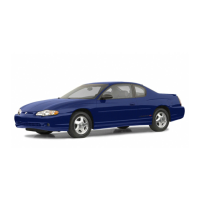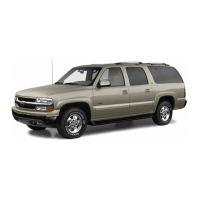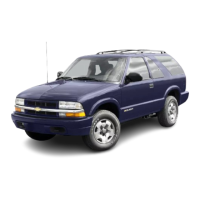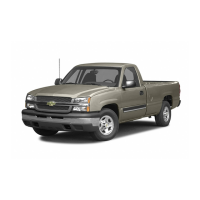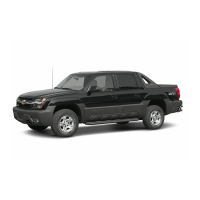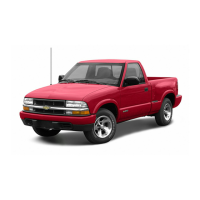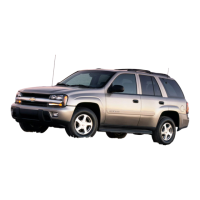Do you have a question about the Chevrolet 2003 Corvette and is the answer not in the manual?
Explains manual and power seat adjustments, including reclining seatbacks and sport seat features.
Details the proper use, importance, and function of safety belts for all occupants.
Provides guidance on proper safety belt use for older children and infants, including restraint systems.
Explains the function, location, and safety precautions associated with the vehicle's air bag system.
Instructions on how to check safety belt systems and air bag covers for proper function and damage.
Information on vehicle keys, including the single ignition key and spare key recommendations.
Details on locking and unlocking doors, lockout protection, and leaving the vehicle secured.
Discusses power windows, express-down feature, and safety precautions for children in vehicles.
Information on the vehicle's theft-deterrent alarm system, including arming and testing procedures.
Guidance on new vehicle break-in procedures and front air dam functionality.
Explanation of the four ignition switch positions: OFF, ACC, ON, and START.
Details on automatic transmission operation, including gear selection and safety features.
Instructions on operating the manual transmission, including shift speeds and downshifting.
Procedures for removing, storing, and installing the removable roof panel safely.
Guidance on lowering and raising the convertible top, including storage and operation.
Information on the memory system for seat, mirror, and steering wheel settings.
Identifies and describes the main components and controls of the instrument panel.
Explains the function of hazard warning flashers and other warning devices.
Details on operating turn signals, lane changes, headlamp controls, and cruise control.
Instructions on setting, increasing, reducing, and ending cruise control operation.
Explanation of exterior lamp controls, including headlamp doors and daytime running lamps.
Information on using fog lamps for visibility and the Twilight Sentinel® automatic lighting system.
Details on instrument panel brightness, parade mode, courtesy, and exit/entry lighting.
Explains the Head-Up Display system, its information display, and adjustment procedures.
Information on using accessory power outlets, including cautions and limitations.
Instructions for using the ashtrays and cigarette lighter, including safety precautions.
Details on the dual automatic climate control system, including automatic and manual operations.
Explanation of solar and ambient temperature sensors and their impact on climate control.
Procedures for clearing fog or frost from windshields and rear windows.
Description of warning lights and gages that signal vehicle status and potential problems.
Overview of the instrument panel cluster, including warning lights and gages.
Explanation of how to read the speedometer and odometer, including measurement units.
Information on the air bag readiness light indicating system status and potential malfunctions.
Description of the voltmeter gage and its readings for battery and charging system voltage.
Explanation of the brake system warning light and potential causes for its illumination.
Information on the ABS warning light and its meaning regarding system function.
Details on the TCS warning light and its indication of system status or issues.
Explanation of the Active Handling System light, its normal operation, and service indicators.
Description of the engine coolant temperature gage and its indication of overheating.
Information on the check engine light, its causes, and potential impact on vehicle performance.
Indicates the status of the theft-deterrent system and potential issues.
Alerts the driver to check vehicle gages for potential problems.
Shows the amount of fuel remaining in the tank and low fuel warnings.
Overview of the DIC display and its control buttons for vehicle information.
Emphasizes defensive driving and the dangers of drunken driving.
Explains the vehicle's control systems: brakes, steering, and accelerator.
Details on braking action, perception and reaction time, and stopping distances.
Explains the function of ABS in preventing braking skids and improving steering.
Describes the TCS system for limiting wheel spin in slippery conditions.
Explains the Active Handling System for maintaining directional control.
Information on the ride control system and its selectable suspension settings.
Covers power steering, magnetic speed variable assist steering, and driving on curves.
Instructions on how to recover a vehicle that has driven off the road onto the shoulder.
Discusses skidding and how to maintain control during emergencies.
Provides tips for safe night driving, including visibility and driver condition.
Guidance on driving safely in rain and on wet roads, including hydroplaning.
Safety tips for navigating city streets with heavy traffic and traffic signals.
Advice on safe freeway driving, including merging, lane changes, and speed.
Checklist for vehicle preparation and personal readiness before starting a long trip.
Tips for driving safely during winter conditions.
Instructions on how to free a stuck vehicle and the 'rocking' technique.
Information on towing your vehicle and recreational vehicle towing procedures.
States that the Corvette is not designed for towing a trailer.
Emphasizes the importance of dealer service and genuine GM parts.
Guidance on performing vehicle maintenance, including safety precautions and ordering manuals.
Information on recommended fuel types, octane ratings, and gasoline specifications.
Details on fuel requirements for California emission standards and potential impacts.
Instructions and safety precautions for refueling the vehicle's fuel tank.
Safety warnings regarding engine components like electric fans and hot parts.
Procedure for opening the vehicle's hood, including safety notes.
Diagram and labels identifying major components in the engine compartment.
Guidance on checking engine oil level, adding oil, and oil specifications.
Location and safety precautions for the engine air cleaner/filter.
Information on checking and changing automatic transmission fluid and filter.
Details on the self-adjusting hydraulic clutch system and fluid checks.
Information on the cooling system, coolant types, and adding coolant.
Describes causes, symptoms, and protection modes for engine overheating.
Overview of the cooling system components, including electric fans and surge tank.
Guidance on checking and adding power steering fluid and recommended types.
Instructions for adding windshield washer fluid and recommended types.
Information on brake fluid, brake wear indicators, and brake pedal travel.
Guidance on replacing brake system parts with approved GM components.
Information on the maintenance-free battery, replacement, and vehicle storage.
Step-by-step instructions for safely jump-starting the vehicle's battery.
Instructions on checking and adding lubricant to the rear axle.
General guidance on bulb replacement and specific procedures for halogen bulbs.
Procedures for opening headlamp doors and replacing headlamp bulbs.
Instructions for accessing and replacing taillamp and turn signal bulbs.
Procedure for accessing and replacing back-up lamp bulbs.
Step-by-step guide for removing and installing windshield wiper blade assemblies and inserts.
Information on tire maintenance, including treadwear, pressure, and replacement indicators.
Details on EMT tires, their performance, and tire pressure monitoring.
Guidance on checking tire pressure, when to check, and the Tire Pressure Monitor system.
Advice on selecting and purchasing new tires, including TPC Spec and sizing.
Explanation of tire grades for treadwear, traction, and temperature performance.
Information on factory alignment and balance, and when re-adjustment may be needed.
Guidance on replacing damaged wheels and wheel nuts, emphasizing GM original parts.
Cautions regarding tire chain use, clearance, and potential vehicle damage.
Safety procedures and precautions for lifting the vehicle with a jack.
Instructions for handling a flat tire, especially with Extended Mobility Tires (EMT).
Details on the tire inflator kit components and temporary repair procedure for Z06 models.
Information on the tire sealant, its limitations, and cautions for use with EMT tires.
Instructions for using the air compressor to inflate tires, with engine running.
General tips and warnings for cleaning vehicle surfaces and materials.
Guidance on cleaning interior surfaces like vinyl, leather, and fabric.
Procedures for washing the vehicle's exterior, finish care, and cleaning lamps/lenses.
Tips for cleaning windshields and wiper blades for optimal performance.
Instructions for cleaning and protecting the convertible top.
Guidance on cleaning aluminum wheels and avoiding surface damage.
Advice on repairing stone chips, scratches, and other paint finish damage.
List of GM-approved cleaning products available from dealers.
Information on the Vehicle Identification Number (VIN) and engine identification.
Overview of the vehicle's electrical system, add-on equipment, and accessory power plug.
Explanation of the fuse system, circuit protection, and fuse block locations.
Table of approximate fluid capacities and vehicle specifications in English and metric.
Details on engine types, VIN codes, spark plug gaps, firing orders, and engine data.
List of common replacement parts and their corresponding part numbers.
Diagram illustrating the routing of engine accessory drive belts.
Introduction to the maintenance schedule, its organization, and importance.
Details on engine oil changes and other services based on mileage intervals.
Owner tasks for checks and services at various intervals, like fuel fill and monthly checks.
Services to perform twice a year, including restraint system and wiper blade checks.
Annual services such as key lock cylinder and body lubrication.
Procedure for checking the starter switch and its operation in different gears.
Checks for parking brake holding ability and automatic transmission park mechanism.
Inspections for steering, suspension, tires, wheels, and exhaust systems.
List of recommended fluids and lubricants, including part numbers and specifications.
A section to record performed maintenance services, dates, and odometer readings.
Overview of customer assistance procedures and how to resolve concerns.
Steps for resolving customer concerns, involving dealership management and assistance centers.
Contact information for Chevrolet assistance in the United States, Canada, and overseas.
Information on a program to reimburse adaptive equipment costs for qualified applicants.
Details on the Chevrolet Roadside Assistance Center services and membership.
How to report vehicle safety defects to NHTSA and General Motors.
How to report vehicle safety defects to Transport Canada and General Motors of Canada.
Contact information for reporting vehicle safety defects directly to General Motors.
How to order service manuals, bulletins, and owner publications.
Explains manual and power seat adjustments, including reclining seatbacks and sport seat features.
Details the proper use, importance, and function of safety belts for all occupants.
Provides guidance on proper safety belt use for older children and infants, including restraint systems.
Explains the function, location, and safety precautions associated with the vehicle's air bag system.
Instructions on how to check safety belt systems and air bag covers for proper function and damage.
Information on vehicle keys, including the single ignition key and spare key recommendations.
Details on locking and unlocking doors, lockout protection, and leaving the vehicle secured.
Discusses power windows, express-down feature, and safety precautions for children in vehicles.
Information on the vehicle's theft-deterrent alarm system, including arming and testing procedures.
Guidance on new vehicle break-in procedures and front air dam functionality.
Explanation of the four ignition switch positions: OFF, ACC, ON, and START.
Details on automatic transmission operation, including gear selection and safety features.
Instructions on operating the manual transmission, including shift speeds and downshifting.
Procedures for removing, storing, and installing the removable roof panel safely.
Guidance on lowering and raising the convertible top, including storage and operation.
Information on the memory system for seat, mirror, and steering wheel settings.
Identifies and describes the main components and controls of the instrument panel.
Explains the function of hazard warning flashers and other warning devices.
Details on operating turn signals, lane changes, headlamp controls, and cruise control.
Instructions on setting, increasing, reducing, and ending cruise control operation.
Explanation of exterior lamp controls, including headlamp doors and daytime running lamps.
Information on using fog lamps for visibility and the Twilight Sentinel® automatic lighting system.
Details on instrument panel brightness, parade mode, courtesy, and exit/entry lighting.
Explains the Head-Up Display system, its information display, and adjustment procedures.
Information on using accessory power outlets, including cautions and limitations.
Instructions for using the ashtrays and cigarette lighter, including safety precautions.
Details on the dual automatic climate control system, including automatic and manual operations.
Explanation of solar and ambient temperature sensors and their impact on climate control.
Procedures for clearing fog or frost from windshields and rear windows.
Description of warning lights and gages that signal vehicle status and potential problems.
Overview of the instrument panel cluster, including warning lights and gages.
Explanation of how to read the speedometer and odometer, including measurement units.
Information on the air bag readiness light indicating system status and potential malfunctions.
Description of the voltmeter gage and its readings for battery and charging system voltage.
Explanation of the brake system warning light and potential causes for its illumination.
Information on the ABS warning light and its meaning regarding system function.
Details on the TCS warning light and its indication of system status or issues.
Explanation of the Active Handling System light, its normal operation, and service indicators.
Description of the engine coolant temperature gage and its indication of overheating.
Information on the check engine light, its causes, and potential impact on vehicle performance.
Indicates the status of the theft-deterrent system and potential issues.
Alerts the driver to check vehicle gages for potential problems.
Shows the amount of fuel remaining in the tank and low fuel warnings.
Overview of the DIC display and its control buttons for vehicle information.
Emphasizes defensive driving and the dangers of drunken driving.
Explains the vehicle's control systems: brakes, steering, and accelerator.
Details on braking action, perception and reaction time, and stopping distances.
Explains the function of ABS in preventing braking skids and improving steering.
Describes the TCS system for limiting wheel spin in slippery conditions.
Explains the Active Handling System for maintaining directional control.
Information on the ride control system and its selectable suspension settings.
Covers power steering, magnetic speed variable assist steering, and driving on curves.
Instructions on how to recover a vehicle that has driven off the road onto the shoulder.
Discusses skidding and how to maintain control during emergencies.
Provides tips for safe night driving, including visibility and driver condition.
Guidance on driving safely in rain and on wet roads, including hydroplaning.
Safety tips for navigating city streets with heavy traffic and traffic signals.
Advice on safe freeway driving, including merging, lane changes, and speed.
Checklist for vehicle preparation and personal readiness before starting a long trip.
Tips for driving safely during winter conditions.
Instructions on how to free a stuck vehicle and the 'rocking' technique.
Information on towing your vehicle and recreational vehicle towing procedures.
States that the Corvette is not designed for towing a trailer.
Emphasizes the importance of dealer service and genuine GM parts.
Guidance on performing vehicle maintenance, including safety precautions and ordering manuals.
Information on recommended fuel types, octane ratings, and gasoline specifications.
Details on fuel requirements for California emission standards and potential impacts.
Instructions and safety precautions for refueling the vehicle's fuel tank.
Safety warnings regarding engine components like electric fans and hot parts.
Procedure for opening the vehicle's hood, including safety notes.
Diagram and labels identifying major components in the engine compartment.
Guidance on checking engine oil level, adding oil, and oil specifications.
Location and safety precautions for the engine air cleaner/filter.
Information on checking and changing automatic transmission fluid and filter.
Details on the self-adjusting hydraulic clutch system and fluid checks.
Information on the cooling system, coolant types, and adding coolant.
Describes causes, symptoms, and protection modes for engine overheating.
Overview of the cooling system components, including electric fans and surge tank.
Guidance on checking and adding power steering fluid and recommended types.
Instructions for adding windshield washer fluid and recommended types.
Information on brake fluid, brake wear indicators, and brake pedal travel.
Guidance on replacing brake system parts with approved GM components.
Information on the maintenance-free battery, replacement, and vehicle storage.
Step-by-step instructions for safely jump-starting the vehicle's battery.
Instructions on checking and adding lubricant to the rear axle.
General guidance on bulb replacement and specific procedures for halogen bulbs.
Procedures for opening headlamp doors and replacing headlamp bulbs.
Instructions for accessing and replacing taillamp and turn signal bulbs.
Procedure for accessing and replacing back-up lamp bulbs.
Step-by-step guide for removing and installing windshield wiper blade assemblies and inserts.
Information on tire maintenance, including treadwear, pressure, and replacement indicators.
Details on EMT tires, their performance, and tire pressure monitoring.
Guidance on checking tire pressure, when to check, and the Tire Pressure Monitor system.
Advice on selecting and purchasing new tires, including TPC Spec and sizing.
Explanation of tire grades for treadwear, traction, and temperature performance.
Information on factory alignment and balance, and when re-adjustment may be needed.
Guidance on replacing damaged wheels and wheel nuts, emphasizing GM original parts.
Cautions regarding tire chain use, clearance, and potential vehicle damage.
Safety procedures and precautions for lifting the vehicle with a jack.
Instructions for handling a flat tire, especially with Extended Mobility Tires (EMT).
Details on the tire inflator kit components and temporary repair procedure for Z06 models.
Information on the tire sealant, its limitations, and cautions for use with EMT tires.
Instructions for using the air compressor to inflate tires, with engine running.
General tips and warnings for cleaning vehicle surfaces and materials.
Guidance on cleaning interior surfaces like vinyl, leather, and fabric.
Procedures for washing the vehicle's exterior, finish care, and cleaning lamps/lenses.
Tips for cleaning windshields and wiper blades for optimal performance.
Instructions for cleaning and protecting the convertible top.
Guidance on cleaning aluminum wheels and avoiding surface damage.
Advice on repairing stone chips, scratches, and other paint finish damage.
List of GM-approved cleaning products available from dealers.
Information on the Vehicle Identification Number (VIN) and engine identification.
Overview of the vehicle's electrical system, add-on equipment, and accessory power plug.
Explanation of the fuse system, circuit protection, and fuse block locations.
Table of approximate fluid capacities and vehicle specifications in English and metric.
Details on engine types, VIN codes, spark plug gaps, firing orders, and engine data.
List of common replacement parts and their corresponding part numbers.
Diagram illustrating the routing of engine accessory drive belts.
Introduction to the maintenance schedule, its organization, and importance.
Details on engine oil changes and other services based on mileage intervals.
Owner tasks for checks and services at various intervals, like fuel fill and monthly checks.
Services to perform twice a year, including restraint system and wiper blade checks.
Annual services such as key lock cylinder and body lubrication.
Procedure for checking the starter switch and its operation in different gears.
Checks for parking brake holding ability and automatic transmission park mechanism.
Inspections for steering, suspension, tires, wheels, and exhaust systems.
List of recommended fluids and lubricants, including part numbers and specifications.
A section to record performed maintenance services, dates, and odometer readings.
Overview of customer assistance procedures and how to resolve concerns.
Steps for resolving customer concerns, involving dealership management and assistance centers.
Contact information for Chevrolet assistance in the United States, Canada, and overseas.
Information on a program to reimburse adaptive equipment costs for qualified applicants.
Details on the Chevrolet Roadside Assistance Center services and membership.
How to report vehicle safety defects to NHTSA and General Motors.
How to report vehicle safety defects to Transport Canada and General Motors of Canada.
Contact information for reporting vehicle safety defects directly to General Motors.
How to order service manuals, bulletins, and owner publications.
| Brand | Chevrolet |
|---|---|
| Model | 2003 Corvette |
| Category | Automobile |
| Language | English |


